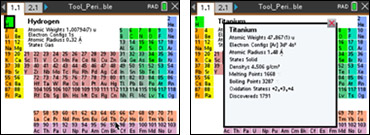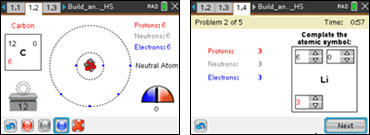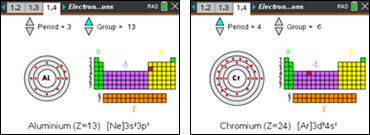Best of Chemistry Activities for the Fall Semester
The ScienceNspired.com website is an excellent resource for any science teacher looking for lessons and content that can be used either in person or online. The colorful and engaging simulations help bring the concepts to life for students by enabling them to test variables and challenge their own ideas. Take a look at some of the best chemistry activities below. These are just a few of the many activities available for free with your TI-Nspire™ CX Premium Teacher Software or TI-Nspire™ CX or TI-Nspire™ CX II graphing calculator. Don’t have the software? Click here to get started.
1. Skills of Science: Tool — Periodic Table
This is a great tool for chemistry students. The Texas Instruments periodic table is completely interactive and offers rich detail for each element. It’s a must-have for every chemistry student!

2. Atomic Structure and Periodic Table: Periodicity of Properties
This lesson is great for introducing the concepts of periodicity and the periodic table. The lesson provides some history about the development of the periodic table, how it works and the patterns it reveals.

3. Atomic Structure and Periodic Table: Build an Atom (HS)
This is a great way to introduce students to the structure of the atom. They will construct atoms with neutrons, protons and electrons, all while discovering the patterns of atomic number, atomic mass and properties of different atoms. Students then play a fun game to test their knowledge. This is based on the popular Phet simulations.

4. Atomic Structure and Periodic Table: Elements — Electron Configurations
Discovering how the periodic table is organized can be both rewarding and daunting. This activity helps by giving students the ability to explore the various periods and groups to see how it works and reveal the patterns.

5. Chemical Bonding: Intermolecular Forces
So much of chemistry is invisible to students. We can sense the beginnings and results of chemical reactions, but we can’t see what happens at the atomic level. This activity attempts to help students understand intermolecular and intramolecular forces through several animations. This is a great way to introduce a very abstract concept.

6. Chemical Formula: Ionic Compounds — Why Am I Charged?
When you are ready to introduce charges and bonding with students, start with this simulation-based activity. It goes over the basics of anions/cations and how charges work. Students can test their abilities by choosing from many different ions.

7. Chemical Formula: Writing Chemical Formulas
Learning the rules of writing chemical formulas and then applying them takes a lot of practice. This TI-Nspire™ lesson enables students to try lots of combinations of cations and anions.

About the author: Erick Archer is a Market Strategy Manager at Texas Instruments and works with science and STEM teachers in the implementation of TI technology. He is also a former high school science teacher, father of two sons, married to his high school sweetheart and LOVES baseball.
Tagcloud
Archive
- 2025
- 2024
- 2023
- 2022
-
2021
- January (2)
- February (3)
- March (5)
-
April (7)
- Top Tips for Tackling the SAT® with the TI-84 Plus CE
- Monday Night Calculus With Steve Kokoska and Tom Dick
- Which TI Calculator for the SAT® and Why?
- Top Tips From a Math Teacher for Taking the Online AP® Exam
- Celebrate National Robotics Week With Supervised Teardowns
- How To Use the TI-84 Plus Family of Graphing Calculators To Succeed on the ACT®
- AP® Statistics: 6 Math Functions You Must Know for the TI-84 Plus
- May (1)
- June (3)
- July (2)
- August (5)
- September (2)
-
October (4)
- Transformation Graphing — the Families of Functions Modular Video Series to the Rescue!
- Top 3 Halloween-Themed Classroom Activities
- In Honor of National Chemistry Week, 5 “Organic” Ways to Incorporate TI Technology Into Chemistry Class
- 5 Spook-tacular Ways to Bring the Halloween “Spirits” Into Your Classroom
- November (4)
- December (1)
-
2020
- January (2)
- February (1)
- March (3)
- April (1)
- May (2)
- July (1)
- August (2)
- September (3)
-
October (7)
- Tips for Teachers in the time of COVID-19
- Top 10 Features of TI-84 Plus for Taking the ACT®
- TI Codes Contest Winners Revealed
- Best of Chemistry Activities for the Fall Semester
- Best of Biology Activities for the Fall Semester
- Best of Physics Activities for the Fall Semester
- Best of Middle Grades Science Activities
- November (1)
- December (2)
- 2019
-
2018
- January (1)
- February (5)
- March (4)
- April (5)
- May (4)
- June (4)
- July (4)
- August (4)
- September (5)
-
October (9)
- Art in Chemistry
- Which Texas Instruments (TI) Calculator for the ACT® and Why?
- Meet TI Teacher of the Month: Jessica Kohout
- Innovation in Biology
- Learning With Your Students
- A first-of-its-kind STEM strategy charts path to help educators
- #NCTMregionals Hartford 2018 Recap
- The Math Behind “Going Viral”
- Real-World Applications of Chemistry
-
November (8)
- Testing Tips: Using Calculators on Class Assessments
- Girls in STEM: A Personal Perspective
- 5 Teachers You Should Be Following on Instagram Right Now
- Meet TI Teacher of the Month: Katie England
- End-of-Marking Period Feedback Is a Two-Way Street
- #NCTMregionals Kansas City 2018 Recap
- Slope: It Shouldn’t Just Be a Formula
- Hit a high note exploring the math behind music
- December (5)
- 2017
- 2016
- 2015
